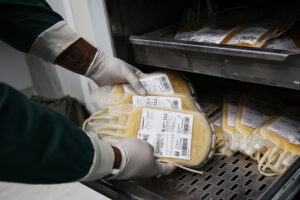Annually, 2.4 million units of plasma are transfused in the U.S. Approximately a quarter to half of plasma transfusions are given prophylactically to prevent perceived risk of bleeding in patients undergoing invasive procedures with increased international normalized ratios (INR). In order to assess the efficacy of this practice, a pilot randomized clinical trial was conducted at five university hospitals. Between January 2016 to November 2019, 534 adult patients were screened for trial; 477 patients were excluded mainly because they were on anticoagulants, actively bleeding, fluid overloaded, or too ill. Fifty-seven patients, with INR levels between 1.50 and 2.50 who were scheduled to have an invasive procedure outside of the operating room were randomized to receive either prophylactic plasma (N=27) or no transfusion (N=30). No differences in hemoglobin levels were observed between the two study arms. INR levels were modestly reduced in the transfused patients: 38.5% (10/27) of patients in the plasma arm had a post procedure INR less than 1.5 compared to 3.6% (1/30) in the no transfusion arm (p<0.01). This trial suggests that prophylactic plasma may have little benefit for hospitalized patients undergoing minor invasive procedures and future resources should be aimed at identifying patients with an increased risk of bleeding.
References:

